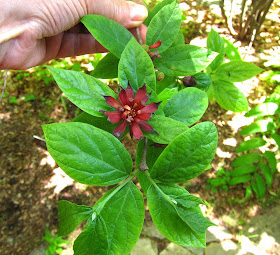How to describe a trip to Paradise? Neither words nor photos can convey the delight that I and my fellow flower enthusiasts Sue and Nan and Ruth and Ed (left to right) enjoyed on our trip to the New England Wildflower Society's Garden in the Woods in Framingham, Massachusetts. We all met at the garden last Thursday in time to picnic together before exploring the trails through one of the most magnificent collections of native plants to be found in the eastern U.S.

I suppose most folks could "do" the tour of the gardens in a couple of hours, but our group inched our way plant by plant to complete about half of the tour in the rest of the day. We then convened to a most congenial bed and breakfast in nearby Lincoln, Thoreau's Walden B&B, situated within view of Walden Pond, where we rested up to continue our explorations the following day.
We found many plants that are very familiar to us in northern New York, including some that are considered quite rare in New England. I am sorry now that I failed to take photos or notes regarding these familiar plants, since I can't remember now which ones they were. (Maybe Ed or Ruth will remind me.) I focused my attention more on those plants that I never have found near my home, such as this lovely Yellow Stargrass. New York State is within its range, but I have never seen it.
This dainty Yellow Pimpernel could also reside in New York, but this is the first time I ever laid eyes on its perfectly spherical balls of tiny blooms.
Perhaps some day in my local paddlings I might come across this beautiful Golden Club.
I doubt I will ever find Climbing Fern, a really rare one where I live. Sue told me that when Henry David Thoreau once found it, he very carefully kept its location secret. A very unferny-looking fern, it develops its spores in the undercurled edges of its leaves.
Braun's Holly Fern is another fern I doubt I will ever see in my local woods, so I'm very glad I got to see its handsome brown-stalked fronds here.
Ed told me he has seen this pretty pink-flowered Bristly Locust near the Mohawk River, but that's an area I rarely visit. What a sight it would be to see whole trees-ful of these blooms!
These next plants I have no hope of ever seeing near home, since their range is much more to the south. This is Carolina Sweetbush, which, despite its appealing name, is poisonous to ingest. But lovely to look at.
Oh gosh, I neglected to write down the name of the fir these cones are sprouting from! But rather than tossing the photo, I include it here because those cones are just so exquisitely beautiful.
This Blue False Indigo is also really beautiful, a plant that is native from Pennsylvania south, but which has escaped from gardens to grow wild in New England now. But not yet in Saratoga County, that I know of, although we do have the related Wild Lupine, which looks quite a bit like it.
Here's another amazing native from more southerly realms, but it sure is thriving in the Garden in the Woods. It's called Turkey Beard, not because of its spectacular starry blooms, but because of the long narrow strands of its leaves that lie on the ground around it.
We have lots of Pitcher Plants in our northern bogs, but none that look like this Green Pitcher Plant from more southern regions.
There were dozens and dozens more plants, some beautiful, some not, but all of them fascinating. I can't believe I did not take photos of the spectacular rhododendrons, blooming now in all their glorious colors, pink and white and coral and even blazing orange. Maybe I neglected them because these native blooming shrubs are also such common garden plants. At any rate, we could only take in so much ravishing plant material at one time, and we were glad to retire at the end of a long day to our most hospitable B&B. Sue and Nan and Ruth were eager to walk around Walden Pond before supper, despite a chilly wind.
 I started out to accompany them, but soon turned back, my ears stinging from the wind, to keep Ed company with his nice bottle of champagne in our inn's commodious Great Room.
I started out to accompany them, but soon turned back, my ears stinging from the wind, to keep Ed company with his nice bottle of champagne in our inn's commodious Great Room.When the ladies returned, they brought reports of finding a single One-flowered Cancer Root growing out of a sandy bank, a big surprise. (And one that would probably be invisible to anyone other than these practiced botanizers.) Probably the commonest plant in the woods surrounding Walden Pond is the shrub called Sweet Pepperbush or Clethra. What lovely shiny leaves it has, and later those dry brown seed heads will be replaced by spikes of fragrant white blooms, a favorite of butterflies.
A perfect day, sunny but cool and breezy to keep the bugs away. And there we were, in one of the loveliest places on earth. With some of the nicest people for companions. Heaven!














Thank-you for sharing the joy of your outing with your closest friends with your readers!
ReplyDeleteAnd thank YOU, catharus, for always coming along with me on my adventures.
ReplyDelete